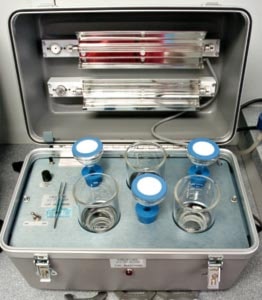A tiny, tidy water lab in the Environmental Health Services building is responsible for safeguarding the territory’s drinking water.
The lab, set up in a converted office on Hospital Road, received national accreditation on Tuesday.
“We are very small,” said health services manager Lynn Richards.
“And I felt confident standing up in court defending our findings, but that’s nowhere near accreditation.”
In 2002, the lab hired an Outside auditor to draft a quality assurance program. The audit was 33 pages long.
“There were lots of challenges,” said Richards, noting it took the lab four years to get its accreditation.
There were checks and balances every step of the way, she said, gesturing towards two clocks on the wall.
“For example, if the power goes off, we needed to be able to tell how long it’s been off,” said Richards.
Looking to other labs for solutions, Richards was told a $12,000 data logger would solve the problem.
Instead, she and water lab technician Justin Lemphers scoured Whitehorse for a plug-in analog clock.
They couldn’t find one.
All the analog clocks are battery operated, said Richards.
But she didn’t give up.
Online, Richards found the perfect clock on EBay. It cost $60.
“It was hard to find one that wasn’t an antique,” she said.
Now, if the power goes off, the plug-in analog clock stops and its hands freeze in place, while the battery-operated analog clock, hanging beside it, keeps ticking away documenting how long the power’s been off.
“It was a $60 solution, instead of a $12,000 one,” said Richards.
“And the auditor loved it.”
The lab’s accreditation is specific to its drinking-water testing methodology, which has been the same since 1986, when the lab began operation as a field laboratory.
“But most of the original equipment has been replaced,” said Richards.
If the lab changed its methodology, it would have to undergo a new accreditation process.
The city sends its water to BC for testing, weekly, said Lemphers.
Why?
“Because the Yukon lab was not accredited, and they’re required to use an accredited lab,” he said.
But now, the city could do all its testing in Whitehorse, he added.
Shipping Outside is challenging, because water samples must arrive at the lab 24 hours after they’ve been bottled at their source.
Even getting water samples to Whitehorse from some of the more remote communities, like Old Crow, can be tricky, said Richards.
The samples have to be refrigerated, but can’t be frozen, she said.
If they come in too warm, or past the 24-hour window, they can’t be accurately tested for bacteria, added Lemphers.
Lemphers, who was working as a mineral assayer before taking over the water lab last year, tests 18 samples at a time.
The water is run through a small filter porous enough to let liquid through, but not dirt and bacteria, said Richards.
The filter is then treated with a growth medium and incubated.
If there are bacteria on the filter, a colony of it will grow, said Lemphers, rummaging through a hazardous waste container in the lab.
It was filled with plastic cases, each containing a small, circular filter.
Many were still white.
But Lemphers pulled out one that was filled with a sprinkling of tiny, hot-pink dots.
This is what total coliforms look like in drinking water, he said.
And if E. Coli were present it would show up a purple-blue, he added.
He rifled through the tossed-out samples, but couldn’t find any E. Coli.
The lab discovers it at least once a month, said Lemphers.
But it doesn’t test for the OH157 strain, which killed seven people in Walkerton, Ontario in 2000.
It can’t.
Instead, the lab tests for another strain of E. Coli.
“It’s accepted practice to test the pathway of this E. Coli,” said Lemphers.
“Because you never find OH157 growing in water where this E. Coli doesn’t.”
The lab grows E. Coli and total coliforms, and uses the bacteria to run quality tests on the lab’s equipment and mediums.
But it doesn’t grow OH157.
That would be too dangerous, said Lemphers.
“And we don’t have the proper equipment.”
The water lab only does presence/absence testing, said Richards.
It does not determine how many total coliforms or E. Coli bacteria are in any given sample.
“And our lab cannot test for chemicals,” said Lemphers.
These samples still have to be sent Outside.
If the lab discovers total coliforms in a sample, it asks for another. If the bacteria is still present, a health officer inspects the well or water source and tries to sort out where the bacteria is coming from, said Lemphers.
If it discovers E. Coli, a boil-water advisory is issued immediately, said Lemphers.
But sometimes E. Coli is discovered in a sample because someone was handling chicken or the tap was dirty, he added.
“So we try to get pure samples.”
Water testing is free, he added.
